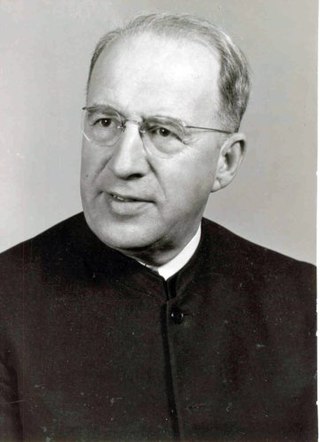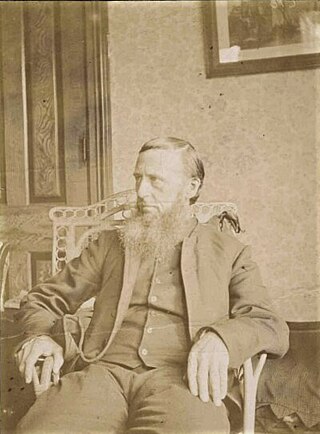Related Research Articles

The Mennonite Church USA is an Anabaptist Christian denomination in the United States. Although the organization is a recent 2002 merger of the Mennonite Church and the General Conference Mennonite Church, the body has roots in the Radical Reformation of the 16th century.

Goshen College is a private Mennonite liberal arts college in Goshen, Indiana. It was founded in 1894 as the Elkhart Institute of Science, Industry and the Arts, and is affiliated with Mennonite Church USA. The college is accredited by the Higher Learning Commission and has an enrollment of 749 students. While Goshen maintains a distinctive liberal Mennonite worldview and Mennonites make up 30 percent of the student body, it admits students of all religions.
The Mennonite Historical Library (MHL) is considered the world's most prominent and complete collection of resources and artifacts pertaining to Mennonites and related Anabaptist groups. It is housed in the Harold and Wilma Good Library on the campus of Goshen College in Goshen, Indiana. The specialty library was founded in 1906 under the guidance of Harold S. Bender and Ernst Correll. Historian John D. Roth is the current director.

Harold Stauffer Bender was a prominent professor of theology at Goshen College and Goshen Biblical Seminary. His accomplishments include founding both the Mennonite Historical Library and The Mennonite Quarterly Review. He served as president of the American Society of Church History, and was a major scholarly influence on fellow Mennonite theologian John Howard Yoder.

Anabaptist Mennonite Biblical Seminary (AMBS) is an Anabaptist Christian seminary in Elkhart, Indiana, affiliated with Mennonite Church USA and Mennonite Church Canada. It was formerly known as Associated Mennonite Biblical Seminary until its name was changed in 2012.

The General Conference Mennonite Church (GCMC) was a mainline association of Mennonite congregations based in North America from 1860 to 2002. The conference was formed in 1860 when congregations in Iowa invited North American Mennonites to join together in order to pursue common goals such as higher education and mission work. The conference was especially attractive to recent Mennonite and Amish immigrants to North America and expanded considerably when thousands of Russian Mennonites arrived in North America starting in the 1870s. Conference offices were located in Winnipeg, Manitoba and North Newton, Kansas. The conference supported a seminary and several colleges. In the 1990s the conference had 64,431 members in 410 congregations in Canada, the United States and South America. After decades of cooperation with the Mennonite Church, the two groups reorganized into Mennonite Church Canada in 2000 and Mennonite Church USA in 2002.
Located in Smithville, Ohio, Oak Grove Mennonite Church is an historical church that has made a significant contribution to the larger Mennonite denomination, currently pastored by Doug Zehr. Oak Grove started as an Amish church in 1818, as many Amish started settling in Wayne County, Ohio. From humble beginnings the church grew and built a meetinghouse in 1862, one of the earliest of such meetinghouses the Amish have built.
Alan Kreider was an American Mennonite historian. He was the American Professor Emeritus of Church History and Mission at the Anabaptist Mennonite Biblical Seminary in Elkhart, Indiana. His main interests were mission, worship, peace, and ecclesiastical history. Kreider continued to speak, write and publish in these areas of interest until his death in May 2017.

John Fretz Funk was a publisher and leader of the Mennonite Church. Funk published the Herald of Truth from 1864 until 1908 when it merged with the Gospel Witness to form the Gospel Herald. Jacob Clemens Kolb, in his preface to Bless the Lord, O My Soul quotes an unnamed commentator who said, "John F. Funk is the most important [Mennonite] man after Menno Simons."

The Global Anabaptist Mennonite Encyclopedia Online (GAMEO) is an online encyclopedia of topics relating to Mennonites and Anabaptism. The mission of the project is to provide free, reliable, English-language information on Anabaptist-related topics.
John C. Wenger was an American Mennonite theologian and professor.
Peter J. Dyck was a Canadian Mennonite relief worker and pastor best known for his work resettling Russian Mennonite refugees after World War II.

The Women's Missionary and Service Commission, previously known as the Women's Missionary and Service Auxiliary and abbreviated WMSC or WMSA, was a women's organization of the "old" Mennonite Church that originated out of the Mennonite Sewing Circle movement. Named the WMSC in 1971, there were many precursor organizations and it has since evolved into Mennonite Women USA, an organization with a much wider scope.
Olive Mennonite Church is a Mennonite Church located just outside Wakarusa, Indiana, and a member of the Indiana-Michigan Mennonite Conference of Mennonite Church USA.
C. Henry Smith was a Mennonite historian born in Metamora, Illinois. Smith was the first (known) American Mennonite to earn a Ph.D., doing so at the University of Chicago in 1907. C. Henry Smith taught two stints at Goshen College and became the first dean of the college, before going on to teach at Bluffton University for the rest of his life. Smith's doctoral dissertation was published as The Mennonites of America in 1909 and remained the only comprehensive Mennonite history of American Mennonites into the 1950s.
George Jay Lapp was an American missionary to India for the Mennonites. He was ordained in 1905 and became a Bishop in 1928 while in India. Lapp served as interim president of Goshen College from February 1918 until June 1919.
Myron Augsburger is an American Mennonite pastor, professor, theologian, and author. He is the former president of both Eastern Mennonite College and the Council for Christian Colleges and Universities.
Gospel Herald was the official publication of the Mennonite Church from 1908–1998. It was formed from a merger of Gospel Witness and Herald of Truth. As part of the merger of the Mennonite Church and the General Conference Mennonite Church, Gospel Herald merged with The Mennonite of the General Conference Mennonite Church to form a new periodical titled The Mennonite.
Anabaptist/Mennonite Church sexual misconduct cases are cases of acts by theologians, educators, pastors, chaplains, and staff or people in positions of power in Anabaptist/Mennonite churches, institutions, or affiliated organizations deemed as sexual misconduct by church organizations. Some of these cases may also be deemed as sexual abuse by law. There have been a number of cases of sexual misconduct involving notable and influential Anabaptist Christian theologians of the late 20th and early 21st century in North America, and scholarship, media reports, and church magazines have revealed that there have been numerous cases of sexual abuse throughout the history of the Anabaptist/Mennonite Church.
References
- ↑ "Historical Committee of the Mennonite Church". GAMEO. Retrieved 2022-01-04.
- ↑ Kauffman, Jason B. "Archival Collections on the Move". The Mennonite. 2017-08-22. Retrieved 2022-01-04.
- ↑ "Archives". GAMEO. Retrieved 2022-01-04.
- ↑ Sharp, John E. A Chronology of the Historical Committee and Archives of the Mennonite Church. Historical Committee of the Mennonite General Conference. Goshen, IN: 1995.
- ↑ Preheim, Rich. "100 Years: A Century of Minding Mennonite Memory." Mennonite Historical Bulletin 72.July (2011): 6-7. Print.
- ↑ "Historical Committee of the Mennonite Church". GAMEO. Retrieved 2022-01-04.
- ↑ Robinson, Laurie Oswald. "River of Anabaptist story stirred by archival venue change". Mennonite Church USA. 2012-07-11. Retrieved 2022-01-04.
- ↑ Kauffman, Jason B. "Archival Collections on the Move". The Mennonite. 2017-08-22. Retrieved 2022-01-04.
- ↑ Toews, Paul. Mennonites in American Society: 1930 - 1970 : Modernity and the Persistence of Religious Community. Vol. 4. Scottdale, Penn. Herald, 1996. Print. The Mennonite Experience in America.
- ↑ "Archived copy". Archived from the original on April 2, 2012. Retrieved September 16, 2011.
{{cite web}}: CS1 maint: archived copy as title (link)